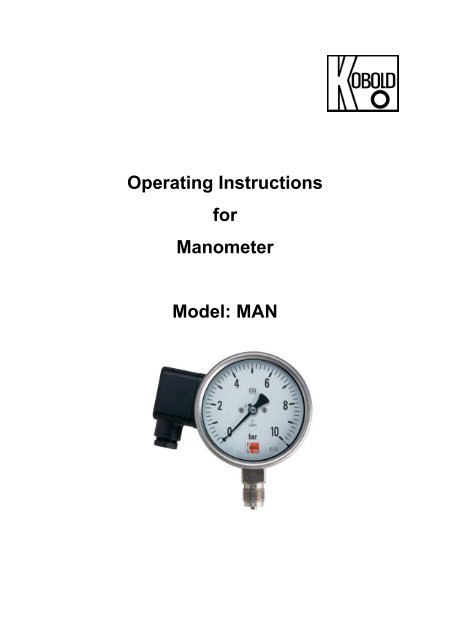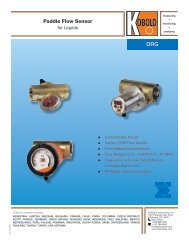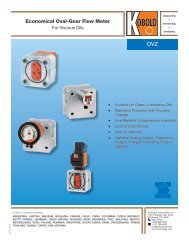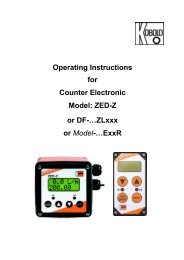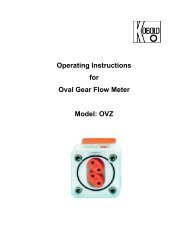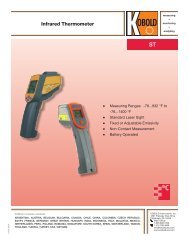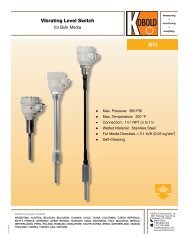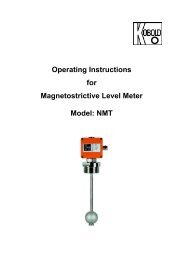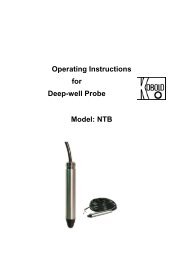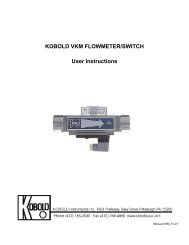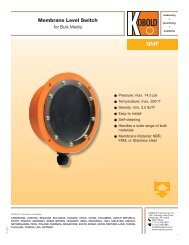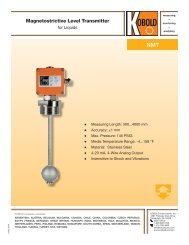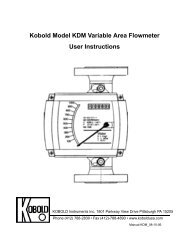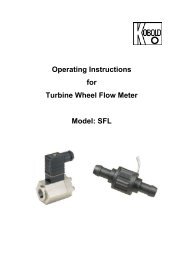Operating Instructions for Manometer Model: MAN - Kobold
Operating Instructions for Manometer Model: MAN - Kobold
Operating Instructions for Manometer Model: MAN - Kobold
- No tags were found...
You also want an ePaper? Increase the reach of your titles
YUMPU automatically turns print PDFs into web optimized ePapers that Google loves.
<strong>Operating</strong> <strong>Instructions</strong><strong>for</strong><strong>Manometer</strong><strong>Model</strong>: <strong>MAN</strong>
<strong>MAN</strong>1. Contents1. Contents........................................................................................................22. Note ..............................................................................................................33. Instrument Inspection....................................................................................34. Regulation Use .............................................................................................45. <strong>Operating</strong> Principle .......................................................................................46. Mounting .......................................................................................................46.1. General................................................................................................46.2. Assembly <strong>for</strong> Differential Pressure <strong>Manometer</strong> ...................................56.3. Assembly <strong>for</strong> Contact <strong>Manometer</strong> .......................................................56.4. Disassembly ........................................................................................67. Sliding or Magnet-Spring Contacts ...............................................................67.1. General................................................................................................67.2. Contact Ratings ...................................................................................77.3. Over-Current Protection Equipment.....................................................78. Inductive and Electronic Contacts.................................................................88.1. General................................................................................................88.2. Mode of Operation...............................................................................88.3. Electrical Data - Inductive Contact.......................................................98.4. Electrical Data - Electronic Contact .....................................................99. Commissioning .............................................................................................99.1. General................................................................................................99.2. Adjustment of Set-Point Value with Contact <strong>Manometer</strong>s .................1010. Maintenance ...............................................................................................1010.1. Cleaning.............................................................................................1011. Technical In<strong>for</strong>mation..................................................................................1012. Declaration of Con<strong>for</strong>mance .......................................................................11Manufactured and Marketed by:<strong>Kobold</strong> Messring GmbHNordring 22-24D-65719 HofheimTel.: 06192-2990Fax: 06192-23398e-mail: info.de@kobold.comInternet: http://www.kobold.com<strong>Kobold</strong>-Messring GmbH Werk IIDruck- und TemperaturmesstechnikMahdentalstraße 44D-71065 SindelfingenTel.: 07031-8677-0Fax: 07031-8677-40e-mail: info.w2.de@kobold.compage 2 <strong>MAN</strong> 03/04
<strong>MAN</strong>2. NotePlease read these operating instructions be<strong>for</strong>e unpacking and putting the unitinto operation. Follow the instructions precisely as described herein.The devices are only to be used, maintained and serviced by persons familiarwith these operating instructions and in accordance with local regulationsapplying to Health & Safety and prevention of accidents.When used in machines, the measuring unit should be used only when themachines fulfil the EWG-machine guidelines.PED 97/23/EGIn acc. with Article 3 Paragraph (3), "Sound Engineering Practice", of thePED 97/23/EC no CE mark.<strong>Model</strong> P max/bar Diagram 7Group 2no dangerous fluidsPipeDiagram 6Group 1dangerous fluids<strong>MAN</strong> < 200 Art. 3, § 3 Art. 3, § 3<strong>MAN</strong> < 500 Art. 3, § 3 Cat. I<strong>MAN</strong> < 1000 Art. 3, § 3 Cat. I<strong>MAN</strong> > 1000 Cat. I Cat. I3. Instrument InspectionInstruments are inspected be<strong>for</strong>e shipping and sent out in perfect condition.Should damage to a device be visible, we recommend a thorough inspection ofthe delivery packaging. In case of damage, please in<strong>for</strong>m your parcel service /<strong>for</strong>warding agent immediately, since they are responsible <strong>for</strong> damages duringtransit.The packing of material must be thoroughly searched, so that no accompanyingaccessories are thrown away.<strong>MAN</strong> 03/04 page 3
<strong>MAN</strong>4. Regulation UseThe units of the model <strong>MAN</strong> serve to measure and monitor pressure-dependentprocesses in machines systems.If applicable, the existing cap-holder on the connection body may be removedimmediately be<strong>for</strong>e connecting measurement conductors, so that no <strong>for</strong>eignparticles may find a chance to enter the pressure chamber. The storage ofmeasurement unit should be arranged in a dry and dust-free area.5. <strong>Operating</strong> PrincipleDepending on the measuring range as well as method of measurement (capsule,diaphragm, bourdon), the pressure to be measured is brought to display via amechanical pointer attachment. The measuring element de<strong>for</strong>ms in flexiblerange.6. Mounting6.1. GeneralThe assembly has to be carried out following the corresponding general technicalregulations <strong>for</strong> pressure measuring devices (e.g. DIN 16255 or EN 837-2).While screwing in at the connection point, the necessary <strong>for</strong>ce may not beapplied via the housing, instead only via key areas designated <strong>for</strong> such apurpose.The installation place of the pressure-gauges should be well accessible andclose to the gas pressure measurements. If possible, above the measuring point.To avoid display deceleration time the distance between pressure withdrawal andpressure connection is to be kept small.Between pressure withdrawal point and measuring unit, a shut-off device isintroduced which allows a renewal and null-point check of the running system. Upto the final commissioning, the shut-off equipment remains closed with themeasurement piping. If pressure peaks are expected, a suitable protectiveequipment may be considered, such as pressure peak suppressor or a similardevice. Alternatively, pressure measuring units with damping-liquid filling, <strong>for</strong>example, glycerine manometer may be provided.The piping up to the measuring unit should allow a vibration-free and stableattachment; in other case a wall holding or an additional <strong>for</strong>tification via anattachment brim on housing should be provided. Alternatively, mounting in a aninstrument panel may be considered.page 4 <strong>MAN</strong> 03/04
<strong>MAN</strong>The attachment of the manometer is to be executed in such a way that theadmissible operating temperature does not violate min. and max. limits. Inaddition manometers and stop valve should be protected through sufficiently longmeasurement piping or water-bag pipes. The temperature influence caninfluence the display accuracy.With gauges <strong>for</strong> gas measurements, accumulation of condensation is to beavoided by suitable laying of piping. If the device <strong>for</strong> operational reasons cannotbe attached above the measuring point, a drainage possibility is to be provided.An additional liquid column may affect the gauge only if this pressure is noted onthe scale. In the unfavourable case, the result of measurement is falsified.For sealing of measuring unit's connections, sealing disks or sealing-edge-ringsare utilised. The connection is recommended with stress-sockets or union-nuts;with that the manometer can be placed in the best reading position. Duringscrew-in or screw-out, the <strong>for</strong>ce must not be exerted on the manometer housing,rather applied only over the four hexagonal connection-clips.Be<strong>for</strong>e attaching the gauges, the measuring piping should be cleaned with theMedium to be measured or with clean compressed air. While squeezing off orblowing through the piping or containers, the gauge may not be over-pressed. Ifthe expected pressure is higher, the manometer must be removed or locked off.6.2. Assembly <strong>for</strong> Differential Pressure <strong>Manometer</strong>Pressure-difference manometers have two pressure connections.On + marked pressure connection, connect higher than expected measuringpressure, on - marked pressure connection, connect lower than expectedpressure. In order to protect the unit, a pressure compensation valve is to beprovided.Through this valve, during commissioning or out of operation state of pressuredifferencemanometer, the measuring chambers on both sides of the measuringmembers are coupled among each other, and <strong>for</strong>emost if both pressure lines areopen or closed, separated from each other. By means of this, a single-sidedstress and thereby a possible overloading of measuring members is avoided.6.3. Assembly <strong>for</strong> Contact <strong>Manometer</strong>In order to avoid bouncing of closed switch and thus resulting increase in wear,care should be taken during installation such that the units remain vibration-free.If the measuring-point is not sufficiently stable, a transmission line with one of themeasuring unit's mounting, separated from the measuring-point should beprovided.The units should be protected against coarse contamination strong variations ofambient temperature.<strong>MAN</strong> 03/04 page 5
<strong>MAN</strong>6.4. DisassemblyBe<strong>for</strong>e disassembling the pressure-measuring unit , the machine/equipmentshould be rendered in a pressure-less state. If possible, the measuring pipeshould be emptied. In case of flat-spring manometers, step-in screws betweenupper and lower flange should not be loosened. Material remains insidedisassembled measuring unit can be dangerous <strong>for</strong> the environment, in whichcase corresponding safety precautions should be adapted. Pressure-measuringunits, whose measuring elements are filled with water or water-based chemicals,may not be allowed to develop frost within.7. Sliding or Magnet-Spring Contacts7.1. GeneralThe built-in limit signal generators (Sliding or magnet-spring contacts) areauxiliary current switches, which open or close connected wired electric circuitsvia the contact arm with the adjusted limit-value, moved by the actual valuepointer.Pay attention during assembly, commissioning and operation of these unitsthat the applicable national safety regulations (such as VDE 0100) arecomplied with. All work must be carried out while the system isdisconnected with the power supply.• The electrical connections may only be carried out by qualified personnel.• Make sure that the electrical connection lines are not supplied with power.• The connection assignments and the switching functions are given on thetype-label of the unit and the connection terminals (1…6) as well as theearthing terminals are tagged accordingly. The supplied mains wires must bemeasured <strong>for</strong> the maximum current intake of the unit and should follow IEC227 or IEC 245.Not observing the relevant regulations can result in serious life and/ormaterial damage.page 6 <strong>MAN</strong> 03/04
<strong>MAN</strong>7.2. Contact RatingsTable 1: Limit-value <strong>for</strong> the contact loadingLimit-value <strong>for</strong> contactSlidingMagnet-spring contactloading with ohmic load Contactunfilled units Unfilled units Filled unitsNominal op. Voltage U eff 250 V 250 V 250 VNominal op. CurrentSwitch-in current 0.7 A 1.0 A 1.0 ASwitch-off current 0.7 A 1.0 A 1.0 AContinuous current 0.6 A 0.6 A 0.6 ASwitching power 10 W / 18 VA 30 W / 50 VA 20 W/20 VANote: Under no circumstances, the limiting values of voltage, current or powermay be overstepped!Table 2: Recommended contact loading with different supply voltages and deviceversionsSliding contactMagnet-spring contactUnfilled housing Unfilled housing Filled housingVoltage Ohmic Inductive Ohmic inductive Ohmic inductiveAC / DC Load load load load load loadAC DC AC DC AC DCcos ϕ > 0.7 cos ϕ > 0.7 cos ϕ > 0.7V mA mA mA mA mA mA mA mA mA230 40 45 25 100 120 65 65 90 40110 80 90 45 200 240 130 130 180 8548 120 170 70 300 450 200 190 330 13024 200 350 100 400 600 250 250 450 150At low voltages, on grounds of switching safety, the switching current may not be less than 20 mA.For higher loads and process safety, as well as <strong>for</strong> the units with liquid -filledhousings, in order to protect against oil turbidity, we recommend the use of anadditional pulse-controlled protective contact relay.7.3. Over-Current Protection EquipmentThese devices do not contain built-in over-current protection. In case, overcurrentprotection is required, we suggest the following values to be consideredin accordance with EN 60 947-5-1.Table 3: Over-current protection deviceVoltage Sliding contact Magnet spring contact24 V 1 A 2 A250 V 0.315 A 1 A<strong>MAN</strong> 03/04 page 7
<strong>MAN</strong>8. Inductive and Electronic Contacts8.1. GeneralInductive contacts (Electronic limit-signal generators, DIN 19234 or NAMUR) aresimply DC voltage switches in two-wire <strong>for</strong>m that only contain transistoroscillators.For the operation of inductive contacts, the use of switching amplifier, such asREL-6000 is recommended.Electronic contact (electronic limit-signal generator in three-wire <strong>for</strong>m) are simpleinductive DC voltage switches <strong>for</strong> switching of DC loads up to 100 mA (directevaluation in SPS).Pay special attention during assembly, commissioning and operation ofthese units such that applicable national safety regulations are followed,<strong>for</strong> example, VDE 0100 etc. All work must be per<strong>for</strong>med while the power isdisconnected from the system.• The electrical connection may only be rendered by qualified personnel.• Make sure, that the electrical connection wires are not active.• The connection terminals and switching functions are given on the type-labeland the connection terminals (1...6) as well as the grounding terminals areaccordingly marked. The wires provided <strong>for</strong> mains connection must beappropriate <strong>for</strong> the largest current intake by the unit and should follow IEC 227or IEC 245.Not complying with the applicable regulations, serious damage to life andmaterials may result.8.2. Mode of OperationThe employed proximity switches, due to their slit-construction are also known asslit-initiators. Th electromagnetic field is concentrated between two coils, whichface each other axially. The switch responds if the current value pointer movesAluminium control-wings in the air-gap between both the coils (slit), which isimmersed in the field. Thereby signal output is achieved without delay andchanging in step with the movement of current value pointer.With inductive contacts, If there is no damping material present within the slitrange,oscillator swings. In this state, system has a very low ohmage(approx. 1kΩ).By immersing the control-wings in the air-gap, the coil system is damped, theoscillations in the oscillator are set up and the system becomes relatively moreresistive (approx. 7kΩ).page 8 <strong>MAN</strong> 03/04
<strong>MAN</strong>8.3. Electrical Data - Inductive ContactNominal voltage8 V DC (Ri approx. 1 kΩ)Self-inductivity 29 µHSelf-capacitance20 nFCurrent-intake (active surfaces free)≥ 3 mACurrent-intake (active surfaces covered)≤ 1 mA8.4. Electrical Data - Electronic ContactOperational voltage10...30 V DCResidual ripple 10 %No load current≤ 10 mAPolarity protectionRestricted (Ub)Inductive protection1 kV; 0.1 ms ; 1kOscillator frequency1000 kHzEMV DIN 60947-5-2 supplement ZAYesSwitching frequency1000 HzOutputPNPSwitching element functionN.O.Switching current≤ 100 mAResidual current ≤ 100 µAVoltage drop (at Imax.)≤ 0.7 V9. Commissioning9.1. GeneralThe measuring unit may only be subjected to pressure slowly, in order to avoiddamage to the measuring unit. Thereby the unit must be monitored continuously.The maximum permitted pressure must not be exceeded in no case.After commissioning of the unit, all piping connected to the measurement unitmust be checked <strong>for</strong> proper sealing. Moreover, if present, the shut-off valve <strong>for</strong>the system pressure at the pressure-intake point must be closed.The pointer moves in the null-point direction (possible temperature changes,condensation, to be considered), check also if the leakage exists. The leakagemust be searched <strong>for</strong> and eliminated by means of suitable measures. Next,repeat system-check as a whole. For the null-point check on running system, theshutt-off equipment must be closed and the measuring element to be released.The pointer must then remain within the null-point tolerance bars, printed on thescale. If the pointer is outside the crossbar, then generally, damage to themeasuring unit may result. Thus manometer should be subjected to an exactcheck, in order to avoid measuring errors, and subsequent accidents.<strong>MAN</strong> 03/04 page 9
<strong>MAN</strong>For display examination during operation, the pressure-measuring unit is lockedoff by means of shutoff device with test-connection disconnected and with thetest-pressure applied. <strong>Manometer</strong>s (display type) operate perfectly requiring nomaintenance.Attention! With dangerous materials, such as Oxygen, Acetylene,flammable or poisonous materials, as well as chillers, compressorsetc. all the general regulations, along with the existing relevantregulatory directions must be observed.9.2. Adjustment of Set-Point Value with Contact <strong>Manometer</strong>sThe adjustment of desired value (set-point value) is carried out via the suppliedadjustment key from the window-panel. The desired value pointers of limit-valueswitches are adjustable freely in the complete scale range. The switching pointshould be checked at operating pressure due to different hysteresis behaviours,particularly with magnet spring contact.For reasons of switching accuracy, switching safety and the working-life ofmechanical measuring systems, the switching points however should not be setin the range 0 to 10% and 90 to 100% of respective measurement span.10. MaintenanceIn case the medium to be measured is not contaminated, the unit ismaintenance-free. An examination of the display and the switching functionshould take place about 1 to 2 times per year. In order to check the display andswitching function, the device is to be separated from the process and besubjected with a test pressure with appropriate inspection temperature.10.1. CleaningClean the devices with a dry or soap-water solution dampened cloth. For thecleaning of the interior of cable box or plug connector, the mains supply linesmust be disconnected. Be<strong>for</strong>e restarting, it must be guaranteed that all parts aredried.11. Technical In<strong>for</strong>mationSee "order confirmation" and data sheet.page 10 <strong>MAN</strong> 03/04
<strong>MAN</strong>12. Declaration of Con<strong>for</strong>manceWe, <strong>Kobold</strong> Messring GmbH, Hofheim-Ts, Germany, declare under our soleresponsibility that the product:<strong>Manometer</strong> with Inductive and Electronic Contacts <strong>Model</strong>: <strong>MAN</strong>to which this declaration relates is in con<strong>for</strong>mity with the standards noted below:DIN EN 31010-1 1994-03DIN EN 60947-1 1992-07DIN EN 60947-1 A11 1994-11DIN EN 60947-5-1 1992-07Also the following EWG guidelines are fulfilled:97/23/EWG<strong>for</strong> <strong>MAN</strong>Low voltage directivepmax > 200 bar97/23/EG PEDCategory I, Table 6, pipe,Group 1 dangerous fluids<strong>for</strong> <strong>MAN</strong>pmax > 1000 bar97/23/EG PEDCategory I, Table 7, pipe,Group 2 non dangerous fluidsHofheim, 06. Dec. 2002H. Peters M. Wenzel<strong>MAN</strong> 03/04 page 11


